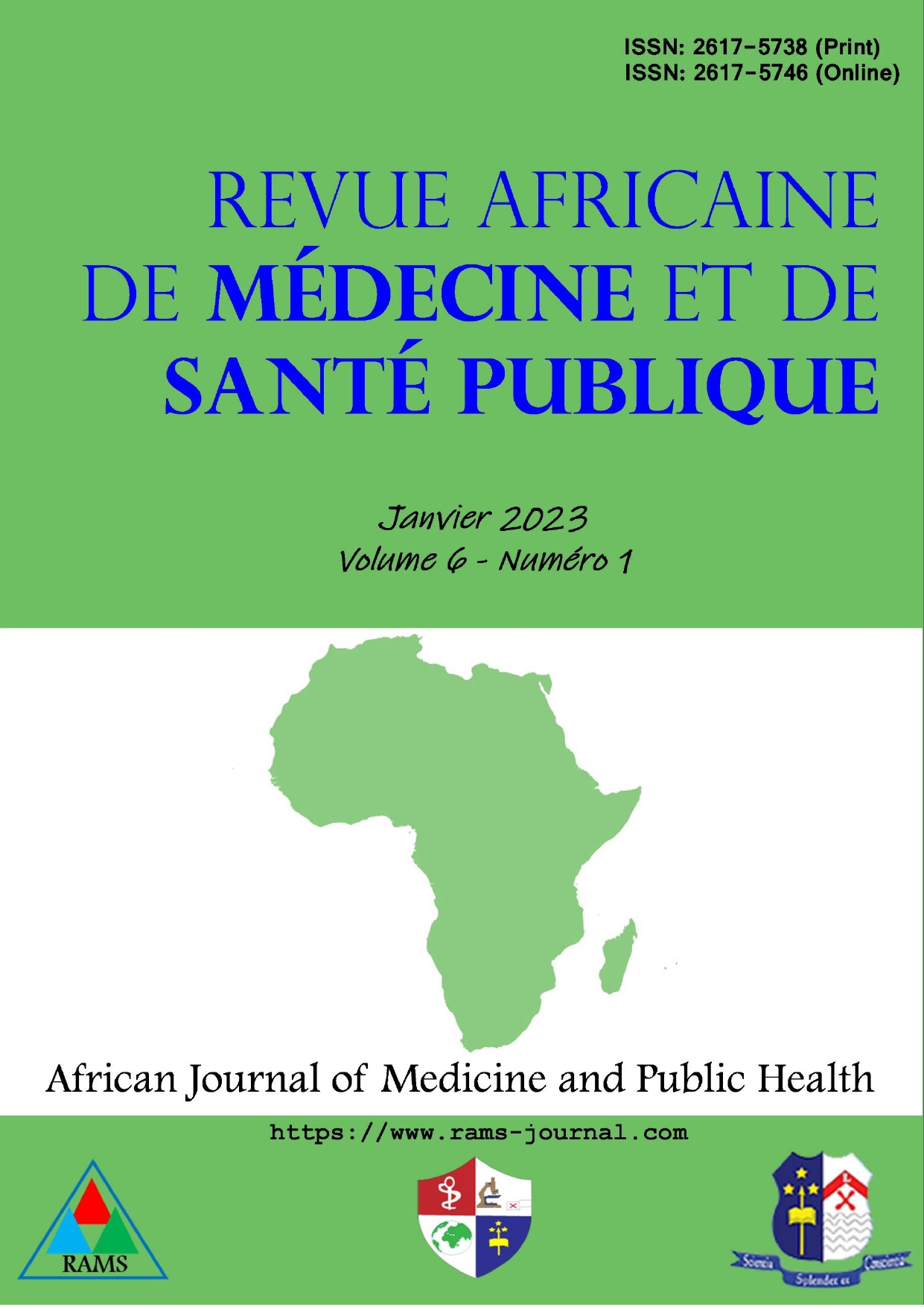Use of contraceptive methods in rural areas in cote d'ivoire: a cross-sectional study
Mots-clés :
Contraception, Côte d’Ivoire, Women of reproductive age, Rural area, useRésumé
Objective: To analyze the factors associated with the use of contraceptive methods in rural
areas.
Patients and methods: This cross-sectional survey took place in May, 2018 in Kodjokro, a
village in the south-east of Côte d'Ivoire. The study population consisted of women of
reproductive age, from 15 to 49 years old. A questionnaire was used to collect data on sociodemographic, gyneco-obstetrical characteristics, knowledge and attitudes and he use of contraceptive methods. The chi-square test was used to measure the associations between
the use of contraceptive methods and each of the characteristics studied.
Téléchargements
Références
Cleland J, Conde-Agudelo A, Peterson H, Ross J, Tsui A. Contraception and health. The
Lancet. July, 14 2012;380(9837):149‑156
Stover J, Ross J. How increased contraceptive use has reduced maternal mortality. Maternal
and Child Health Journal. sept 2010;14(5):687‑695.
Ronsmans C, Graham W. Maternal mortality: who, when, where, and why - The Lancet
Sep 30;368(9542):1189-1200.
Alkema L, Chou D, Hogan D, Zhang S, Moller A-B, Gemmill A, et al. Global, regional, and
national levels and trends in maternal mortality between 1990 and 2015, with scenario-based
projections to 2030: a systematic analysis by the UN Maternal Mortality Estimation InterAgency Group. The Lancet. 2016 Janv 30;387(10017):462‑474.
Kantorová V, Wheldon MC, Ueffing P, Dasgupta ANZ. Estimating progress towards meeting
women’s contraceptive needs in 185 countries: A Bayesian hierarchical modelling study. PLOS
Medicine. 2020 Feb 18;17(2):e1003026.
Alkema L, Kantorova V, Menozzi C, Biddlecom A. National, regional, and global rates and
trends in contraceptive prevalence and unmet need for family planning between 1990 and
: a systematic and comprehensive analysis. The Lancet. 2013 may 11;381(9878):1642‑1652.
Mosso RA, Dore EDA, Kouakou HA, Assi SB, Bakayoko M, Bakayoko Y, et al. Ministère de la
Santé et de la Lutte contre le Sida, Institut National de la Statistique, Côte d’Ivoire. Enquête
Démographique et de Santé et à Indicateurs Multiples de Côte d’Ivoire 2011-2012. Rapport de
synthèse final. MEASURE DHS, ICF International Calverton, Maryland, USA. 2012 ; 591.
Ntambue AM, Tshiala RN, Malonga FK, Ilunga TM, Kamonayi JM, Kazadi ST, et al. Utilisation
des méthodes contraceptives modernes en République Démocratique du Congo: prévalence
et barrières dans la zone de santé de Dibindi à Mbuji-Mayi. Pan African Medical Journal. 2016;26:199
Matungulu CM, Kandolo SI, Mukengeshayi AN, Nkola AM, Mpoyi DI, Mumba SK, et al.
Déterminants de l’utilisation des méthodes contraceptives dans la zone de santé Mumbunda
à Lubumbashi, République Démocratique du Congo. Pan African Medical Journal. 2015; 22:329.
Abidjan.pdf [Internet]. [cité 15 juill 2019]. Disponible sur:
http://www.ins.ci/n/documents/rgph/ABIDJAN.pdf
Mohammed A, Woldeyohannes D, Feleke A, Megabiaw B. Determinants of modern
contraceptive utilization among married women of reproductive age group in North Shoa
Zone, Amhara Region, Ethiopia. Reproductive Health. 2014 Feb 3;11:13.
Sidibe T, Sangho H, Traore MS, Cissé MB, Diallo B, Keîta MM, et al. Connaissances et
pratiques des élèves d’un lycée de Bamako en matière de contraception et prévention des IST.
Le Mali médical. 2006 ; XXI(1):39-42.
Vroh JBB, Tiembre I, Attoh-Touré H, Kouadio DE, Kouakou L, Coulibaly L, et al.
Épidémiologie des avortements provoqués en Côte d’Ivoire. Sante Publique. 2012 Jun 8;Vol.
(HS):67‑76.
Asut O, Ozenli O, Gur G, Deliceo E, Cagin B, Korun O, et al. The knowledge and perceptions
of the first year medical students of an International University on family planning and
emergency contraception in Nicosia (TRNC). BMC Womens Health. 2018 15;18(1):149.
Baranon D, Sanni MA. Recours aux méthodes modernes de contraception par les femmes
de Tchaourou. In : MA Sanni (Eds) Tchaourou, une commune béninoise. Éditions science et
bien commun ; 2017.





